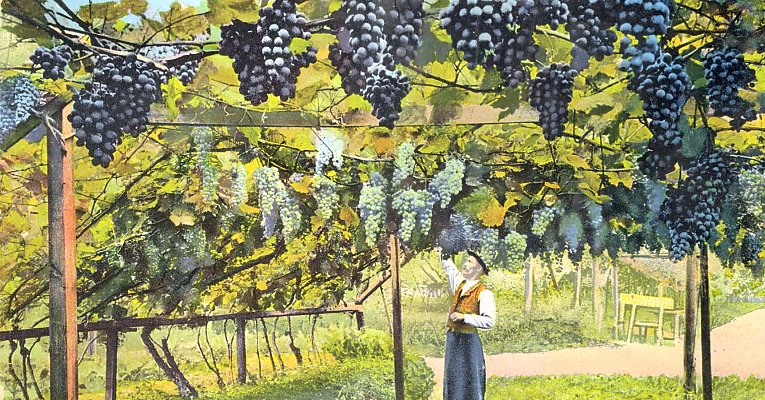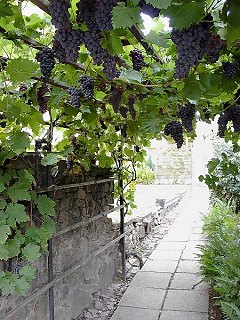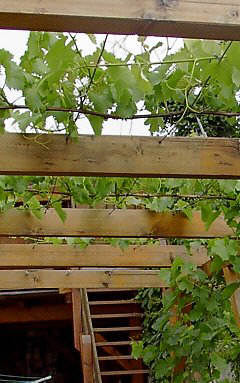Pergola Grapevine Training
Grapevines are ideal for creating "green roofs." Their large leaves are especially effective for creating a canopy of foliage over a pergola or covered walkway! Carports, pergolas and arcades/arbours provide perfect trellis opportunites. Foliage density can be regulated by adjusting the rigour of your winter pruning.

To create green roofs, only the main branches of the vine or the "old wood" (dark brown in the following diagrams) are tied to posts, battens, or wires of the pergola. The fruit-bearing new shoots first grow straight up, but will eventually bend under their own weight and will end up resting on the trellis and intertwining with each other to form a roof of dense foliage.
*Scroll to the bottom to see three variations for training pergolas. Illustrations for: narrow (01), medium (02), and wide (03) pergolas.

Grapevine pergola with tension cables in late autumn (Variation 02 - see below; if suitable, can be used as an intermediate stage for Variation 03).

This particularly dense foliage has been achieved by training the cordons very closely together on wire ropes analogous to our cable system 0040. In this photo, the brown cordons were spur-pruned, and the young grapes and flowers on the young canes can be seen. This layout follows Variation 03 (see below), but is spur pruned.

Variation 01:
For pergolas with a narrow width of 0.5 - 1.0 m. The main arms of the vine are trained straight up and tied parallel to the lengthwise beam. The fruiting canes are about 15 cm apart and will be spur pruned. For each yearly extension of the horizontal cordons, 3 - 6 eyes can be added. To achieve a denser canopy, pruning can be changed to rod pruning (medium pruning).

Variation 02:
For pergolas, arbors, etc.. with a width of 1.0 - 1.5 m. With free-standing pergolas having vines growing on both sides, the total width can be approx. 3.0 m (see photo above left). The cordons are trained along the two external beams of the arbour, then further developed as per Variation 01... although here the branches are further apart- approx. 50 cm. Gradually, pruning technique switches and these branches carrying the young shoots will receive cane pruning.

Variation 03:
For structures wider than for Variation 02. A very versatile form. Training is analogous to the horizontal cordon, whereby several cordons develop from a single vine and form a "comb-like" structure. These cordons need to be about 1 m apart; the canes are initially spur pruned; later they may also be rod pruned and cane pruned.













